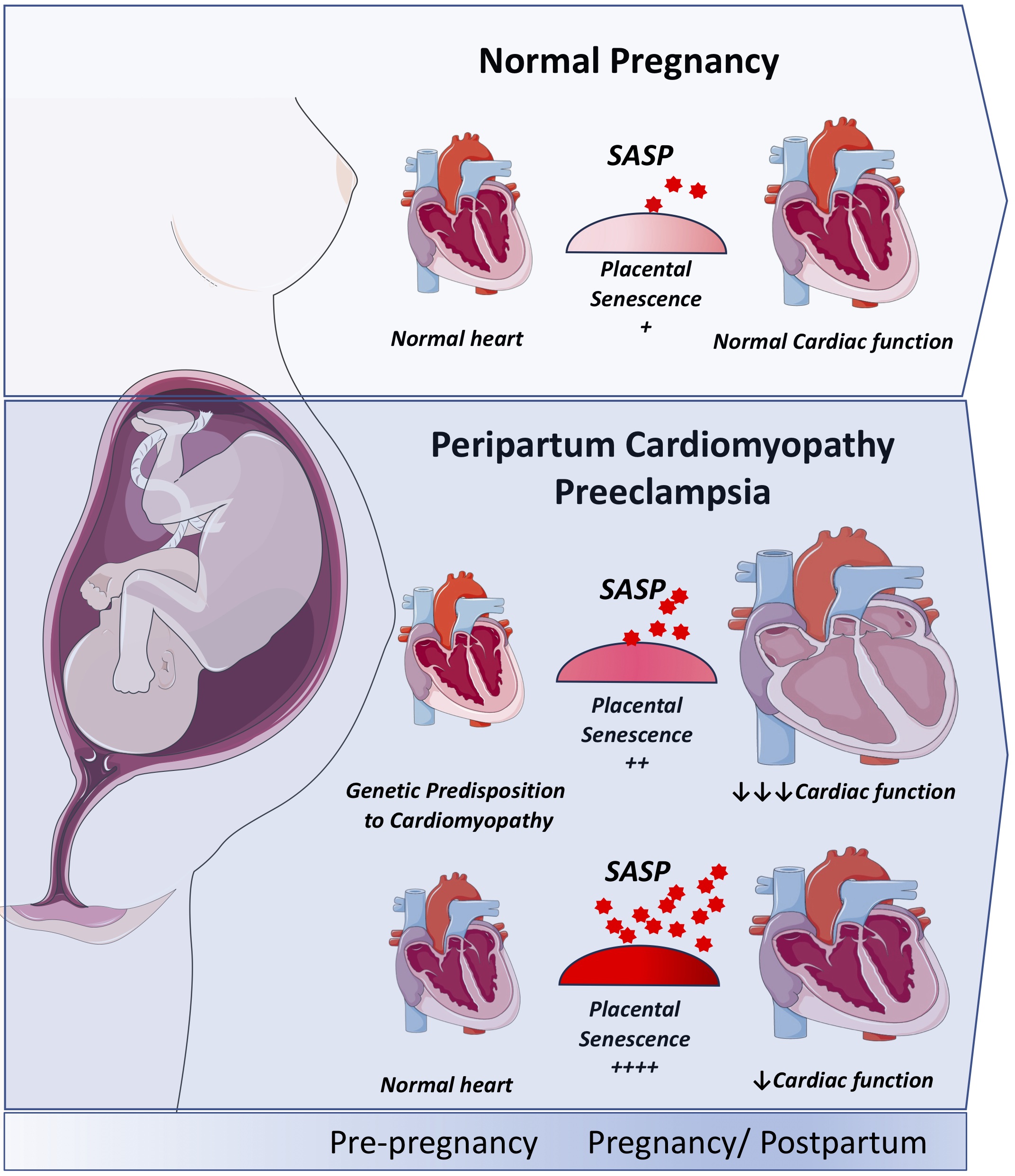Schematic of the role of placental senescence in pregnancy-induced heart failure.
The senescence associated secretory phenotype (SASP) encompasses all the secreted factors generated by senescent cells. Physiological placental senescence is a normal part of pregnancy that leads to the secretion of senescence-associated proteins into the maternal circulation. These SASP factors generally do not affect the function of a healthy maternal heart. However, in conditions in which placental senescence is significantly amplified (such as in peripartum cardiomyopathy and preeclampsia), increased circulating levels of placental-derived SASP can impair the function of the maternal heart.
Peripartum cardiomyopathy (PPCM) is a rare form of heart failure that occurs in women during late pregnancy or shortly after delivery. PPCM is a major cause of maternal mortality, but also one in which the cause remains poorly understood and limited disease-specific treatments exist. A recent study by Roh, Castro, and colleagues published in the April 17, 2024 issue of Science Translational Medicine provides new insights into the elusive pathogenesis of PPCM.
Currently, one of the leading hypotheses in PPCM is that women who develop this disease likely harbor a genetic predisposition for heart failure that is unmasked by circulating factors in pregnancy. What these factors are and why they are released into the maternal circulation during late pregnancy are largely unknown.
The authors performed serum proteomics, a technique used to measure circulating levels of thousands of proteins, in women with PPCM or preeclampsia, a hypertensive disorder of pregnancy that is also one of the major risk factors for PPCM. They identified the senescence-associated secretory phenotype (SASP), a marker of biological aging, as the most highly upregulated processes in the serum of young women with PPCM or preeclampsia. The authors found that this high level of circulating SASP comes from accelerated aging (or senescence) of the placenta. Additionally, in animal models of PPCM presenting a cardiac dysfunction and amplified placental senescence, they showed that returning placental senescence closer to normal physiological levels with a senolytic treatment could improve the function of the maternal heart in PPCM.
This study’s findings implicate a causal role of aging biology in PPCM. While more work is needed before translating these findings to humans, these results provide the first proof-of-concept evidence that modulating placental senescence and its SASP could potentially represent a new approach for diagnostic and therapeutic development in pregnancy-related heart failure.
Paper citation
Roh JD, Castro C, Yu A, Rana S, Shahul S, Gray KJ, Honigberg MC, Ricke-Hoch M, Iwamoto Y, Yeri A, Kitchen R, Guerra JB, Hobson R, Chaudhari V, Chang B, Sarma A, Lerchenmüller C, Al Sayed ZR, Diaz Verdugo C, Xia P, Skarbianskis N, Zeisel A, Bauersachs J, Kirkland JL, Karumanchi SA, Gorcsan J 3rd, Sugahara M, Damp J, Hanley-Yanez K, Ellinor PT, Arany Z, McNamara DM; IPAC Investigators; Hilfiker-Kleiner D, Rosenzweig A. Placental senescence pathophysiology is shared between peripartum cardiomyopathy and preeclampsia in mouse and human. Sci Transl Med. 2024 Apr 17;16(743):eadi0077. PMID: 38630848.
